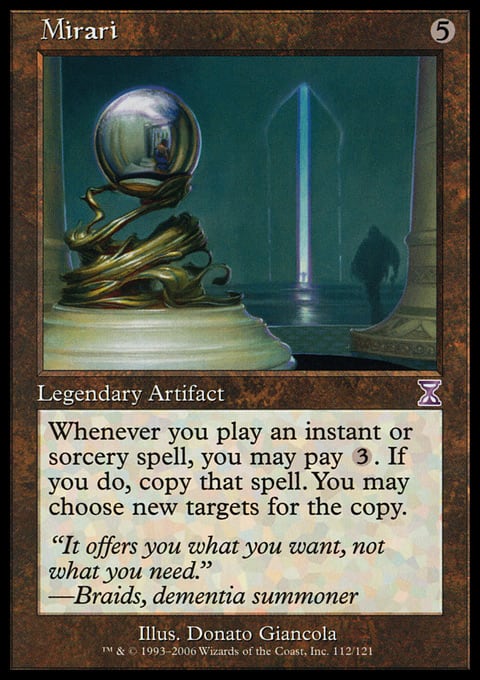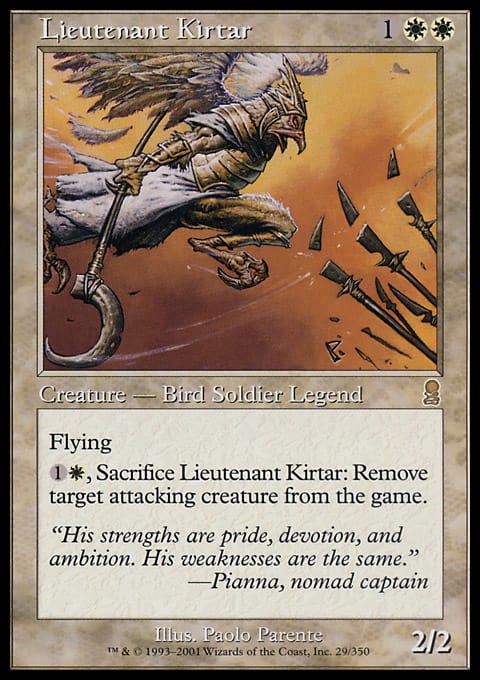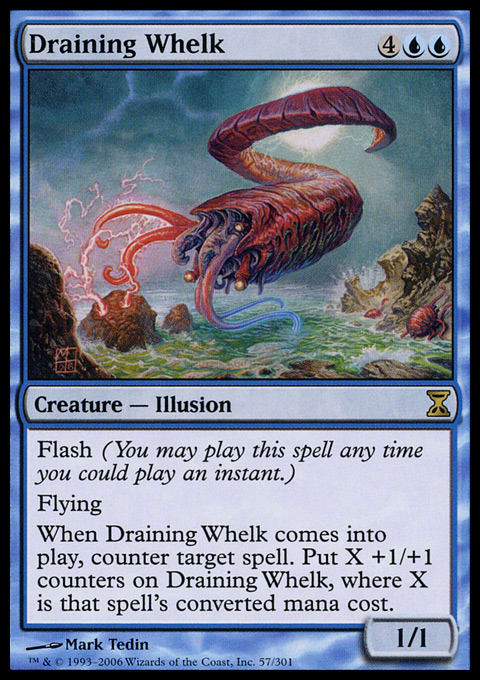There are many times while playing Magic when something happens that you must respond to immediately or else be on your way to defeat. Perhaps an enemy has started to combo off, and you need a Naturalize effect to end it. Maybe a crucial game-winning spell is on the stack and you have to have a Counterspell to solve it. Or you could just be attacked by one or more creatures and you need to remove some in order to survive.
In multiplayer Magic, you don’t know when you need to have an answer to a threat. You certainly won’t see a prelude to what sort of threat it is. You need to have some cards in the grip that can handle a game-ending problem. Imagine a spider. It cautiously waits for its prey to near it, and then, when a bug is ensnared in the web, it strikes! Some Magic cards are like spiders. They wait and linger for prey and then strike to end any threat that prey represented.
This article is a loose sequel to the article I wrote two weeks ago, called The Rattlesnake Effect. A long time ago, a multiplayer writer named Anthony Alongi created a way of analyzing Magic cards in multiplayer games. He looked at them from various angles with animal kingdom analogies. The aspect of a card that sits on a board and keeps people away while threatening harm is a rattlesnake, and we looked at those cards two weeks ago. The aspect of cards that jump out of nowhere to take out an opponent is a spider, and we will examine spiders today.
I do not intend to speak much about the other types at this time, so plankton, gorillas, and cockroaches can stay until later. However, I think it’s very important to look at spiders and rattlesnakes and how they interact with opponents, the board, and each other. In some ways, they are very much the opposites of each other.
For example, two weeks ago, I discussed how Seal of Doom is often better in multiplayer than Dark Banishing. In last week’s article, I built a mono-black Commander deck around Nefarox, Overlord of Grixis, and I included not only a Seal of Doom but instant removal such as Murder. Why would I play Murder when I already had discussed how good rattlesnake cards are?
The answer is a bit complex, but it ultimately boils down to: “Sometimes you need different answers to different threats.”
What Is a Spider?
A spider is any card that is not seen by your opponent but that can be used with severe danger to opposing cards. Clearly, the best and certainly most obvious spiders are those cards that are instants or have flash. My banner spider card is Rout. Take a look at this rare from Invasion. It’s a Wrath of God for 5 mana as a sorcery, but if you pay 2 extra mana, you can Wrath as an instant. That’s a massive amount of versatility.
Imagine that you are attacked by an entire army by an opponent at the multiplayer table. You can never predict what another person is thinking or what he’ll do. When you’re attacked in style, it’s often out of the blue. You’re attacked, and you need an answer. Sure, you could just Fog, but that’s not a good answer. You could sacrifice that Seal of Doom you have to take out one guy, but that’s not enough. Play the Swords to Plowshares in your hand too if you want, and even use the Maze of Ith to prevent damage from an attacker.
There’re still too many creatures to handle. Too many defenses in multiplayer rely on one-on-one answers and are overwhelmed. But you have Rout! Instead of all of those things to jump through, just pay 7 mana and clear out the board. The entire attacking force is gone, along with any other opposing creatures you didn’t like. You can also use Rout to take out a bunch of creatures about to be used to go off with a combo or to clean out the board in a typical Wrath of God style, but you do so at the end of someone’s turn, so you can be the first to drop creatures with all of your mana available. It’s a card with a lot of spider potential.
Spiders typically are cards in the hand because of the unseen part. And they are usually cards that can be played at light speed. The best spiders take out more than one permanent. Sure, there’s a place for Disenchant or Chastise, but there is also a place for Orim's Thunder or Wing Shards. With versatility and card advantage being vitally important concepts in multiplayer, you need to make sure that cards that are spiders also don’t put you back in the card count. Sure, I enjoy the occasional card such as Mortify, Murder, Counterspell, or Lightning Bolt solely as emergency plans, but I prefer to lean on cards such as Dismiss, Summoner's Bane, Annihilate, Violent Eruption, Fire at Will, and the very potent Electrolyze. These cards give you the extra gas beyond a simple trade of my spell for your card.
There is another sort of spider. The flash creature that blocks and kills the offender is certainly a spider. If it just blocks and doesn’t kill the creature it blocked, it was really more of a surprise roadblock than a spider. If I flash out Darksteel Sentinel to block your 6/6 Sun Titan, it’s not a spider—it’s just survival. On the other hand, if I flashed it out to block and slay your 3/3 Hellrider, we are looking better.
Bogardan Hellkite is a particularly dangerous spider. You flash it out to block and slay many attacking creatures, and you can split 5 damage among several other creatures. You could easily kill two creatures with the damage and a third with the body. (Despite its sheer power at the multiplayer table, it’s a cheap card to pick up, so take a look at buying a few.) Ambush Viper and Winged Coatl are solid spiders, but they will die to basically anything they block. They each act as sort of a clunky Rebuke. But if you can keep one alive through regeneration or something, it can flash, block, kill with deathtouch, and stick around. Cloudthresher is likely to flash out and have enough size to kill an attacker while surviving. We all know of others as well (Mistbind Clique, Restoration Angel, and many more).
Another way to spider your table is with a favorite rattlesnake card: something that gives your spells flash. Two weeks ago, I talked about the benefit of Vedalken Orrery and similar cards acting as rattlesnakes. With mana untapped and a full grip, people fear what creatures could come out to block and often attack elsewhere. Well, it also acts a bit as a spider. You can flash out a Barter in Blood, a Vindicate, a Mind Twist, or whatever else your heart desires. You can flash an answer to any problem, and with the cheaper and more powerful sorceries running around, you can abuse the table. Compare the cost difference between the instant Volcanic Geyser and the sorcery Blaze. How much more would Desert Twister cost if it were an instant? Giving all of your cards flash makes them powerful spiders. Even a simple Winding Canyons turns a Flametongue Kavu or Shriekmaw into an instant removal spell that is on a body. A permanent that grants flash to cards in your hand lives on the corner of Spider Street and Rattlesnake Way.
Imagine Magic 2013 legendary creature Yeva, Nature's Herald. With her in play, you can flash out creatures of severe green beef to block and slay folks, so players might not attack you. Then, you can flash out creatures with enters-the-battlefield abilities to Spider-slay problems. Imagine the power of a simple Acidic Slime in your hand when Yeva is out. You can flash it to destroy an annoying permanent and to block a creature that is offending your presence by looking your way. Deathtouch on the Slime will end that critter’s hope of glory. Now consider the power of creatures such as Woodfall Primus, Deranged Hermit, Eternal Witness, and Stingerfling Spider. Do you see how powerful flash becomes when looked at from both spider and rattlesnake angles?
When Are Spiders Valuable?
We’ve already discussed some obvious examples of spider value—when a combo is going off, you are attacked by a giant army, or a game-winning spell is on the stack. Okay, great. But when else do you want a spider?
There are some enchantments and artifacts that are particularly onerous in multiplayer games. When one comes out, you often want a spider to off it at instant speed before it does anything too nasty. Sometimes, you can wait until a sorcery or creature can handle it. You might not like a Mind's Eye, Rhystic Study, or Future Sight, but the cards your opponent will draw with them by your main phase are probably only equal to a Tidings level of power. If you play Indrik Stomphowler on your turn to blast it and then move on, nothing really bad happened.
However, some cards spell trouble. A Mirari with a full grip and a lot of mana is a problem that needs an immediate answer. An Argentum Armor that just was played and equipped on a creature that you suspect will swing your way calls for an immediate answer. The same is true with Eldrazi Conscription on a creature.
Similarly, if an opponent plays a creature with haste and swings, you may want an immediate answer. Do you want to be hit by Akroma the First and its partner Thundermaw Hellkite? You may benefit from something such as Wing Shards in your pocket. It may not be an attack that kills you en masse, but just an annoying one that really changes the life totals at the table that incites your ire.
How do Spiders Play with Rattlesnakes?
We’ve already discussed the value of flash with both rattlesnake and spider goodness. Let’s talk more about rattlesnakes versus spiders. Remember the example I gave above about being attacking my multiple creatures? Let’s flesh out our sample case.
Suppose you have out enough lands, 18 life, four cards in hand, a Maze of Ith, Lieutenant Kirtar, and a Mogg Maniac. One of your opponents has a significant number of creatures out. He decides to attack, and having seen your board, he attacks with enough strength to punch through your defense. You Maze a giant flyer and then block with the Maniac and Kirtar. You sacrifice Kirtar to exile another attacker. You have blocked two attackers, Mazed a third, and exiled a fourth. He has two more creatures.
Rattlesnakes have a good thing going. When an opponent spies our removal, he often won’t attack into it. However, that knowledge can be used against us, as someone plans to attack around it. That’s when having a spider to assist can really help. Imagine that instead of Kirtar, we had a Soul Snare. Now instead of blowing the Snare, tapping the Maze, and blocking with a Maniac, pretend that we just played Starstorm. Now the opponent will need to reload his team with several creatures before attempting to crack our defense again! The rattlesnakes that survive our removal of opposing creatures also stick around to keep folks away in the future. They work turn after turn after turn (again demonstrating how much better they usually are over a simple Rebuke or Terror).
Spiders plug the holes that a rattlesnake defense leaves. Similarly, a defense that relies solely on spiders to do the job will fall very quickly. People will attack not knowing they are there, and then you have to use your spiders over and over again until the till is dry. A spider is a onetime effect, so you need to include them in your deck sparingly and lean on them only when needed.
Note that a spell with buyback will act as a spider the first time you play it, but then as a rattlesnake every subsequent turn you have mana open. If my foe has a Shattering Pulse and I attack with a few artifact creatures, the first time one of my Golems is blown up, it’s a spider. In future turns, if I decide not to attack with my artificial dudes because my opponent has 5 mana open, it acted as a rattlesnake.
What Are Some Good Spiders You’d Recommend?
There are several spiders that I want to recommend here at the end of the article. These have value beyond a simple spider effect that blows one permanent or counters one spell. The first is Draining Whelk. Not only is it a way to counter a spell that might change the board state significantly, but it also is a flying creature of some size. It’s rare that it’s not at least a 5/5 flyer, and you’ll often see it in the double digits. It’s a potent spider. Desertion is another good spider counter because it counters anything, so it has diversity, but it also puts a creature or artifact countered onto your board. It doubles as a nice counter in emergencies and as a way to steal an artifact or creature.
I think Return to Dust is a great, underused Disenchant effect. If you can wait until your turn and play it in a main phase, you can exile two artifacts or enchantments. Exiling one is a great answer because it removes any chance of the target coming back. If you can’t wait, you can still exile one during someone else’s turn. I mention the awesome Orim's Thunder, and it would be a rare R/W casual deck that would not demand having it added. Dismantling Blow will pop an antagonistic artifact or enchantment and draw you two cards if you kick it. There are other good choices as well, such as Relic Crush, Artifact Mutation, Aura Mutation, and Fracturing Gust.
I like my surprise creature removal to either be versatile, such as Putrefy and Murder, or something that has the potential to off multiple creatures. I’ve mentioned many good options, including Starstorm and Rout. Both are great ways of clearing out an entire attack. A card that steals one creature to block another, like Ray of Command or Act of Aggression, not only stops two creatures from damaging you, but usually slays at least one creature, and often both.
Despite my adoration for card advantage from my spiders, there are two I like to rely on in emergencies. Sometimes, you just have to sacrifice card advantage to stay alive. Firestorm and Vengeful Dreams are my parachutes. When you are falling badly, they can arrest your tumble. When someone is slipping four Dragons through your defense, play Vengeful Dreams, discard four cards, and exile all of them. Yes, you traded five cards for four and need to reload your hand and board position later, but you are still alive.
Most damage prevention is neither a rattlesnake nor a spider. Playing a Fog effect doesn’t destroy anything or endanger a board position. Take a look at Divine Deflection or the lesser Captain's Maneuver, though. They will reduce the damage you or your creatures will take and deal that damage to an opposing creature or player. You can imagine it in combat. It saves a creature or keeps you from taking some damage while you off an attacker. That’s a nice swing. Since one in the hand can also save a creature from damage-based removal, it’s versatile enough for your deck. It’s often a two-for-one trade (I save my creature, and you lose yours).
Spiders are important safety valves that keep you alive and enable the other cards in your deck. Understanding when to include them—while also refraining from overreliance—is key. If you can do that, you will become a better player in multiplayer Magic. Good luck!
See you next week,
Abe Sargent




























